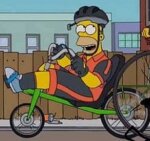The leading cause of bicyclist fatalities (according to NTSB) is…
Our Community › Forums › General Discussion › The leading cause of bicyclist fatalities (according to NTSB) is…
- This topic has 16 replies, 9 voices, and was last updated 5 years, 7 months ago by
mstone.
-
AuthorPosts
-
November 7, 2019 at 1:15 pm #1101078
mstone
ParticipantI guess the people who didn’t feel safe with cars whizzing past were right, Forester notwithstanding?
I did find it interesting that their data has multiple categories for “cyclist failed to yield” but none at all for “motorist failed to yield”. I guess motorists always follow the rules.
November 7, 2019 at 3:44 pm #1101082 lordofthemarkParticipant
lordofthemarkParticipant@mstone 194119 wrote:
I guess the people who didn’t feel safe with cars whizzing past were right, Forester notwithstanding?
I did find it interesting that their data has multiple categories for “cyclist failed to yield” but none at all for “motorist failed to yield”. I guess motorists always follow the rules.
To be fair, didn’t Forrester say leading cause of cyclist crashes or injuries, not fatalities? From what I can gather (including by personal experience) collisions at intersections tend to be at lower speed (while hit by overtakers would be at higher speed) . While the former could still be fatal (esp with a very heavy vehicle like a truck) they are generally less serious.
November 7, 2019 at 8:54 pm #1101085Brendan von Buckingham
Participant@lordofthemark 194123 wrote:
To be fair, didn’t Forrester say leading cause of cyclist crashes or injuries, not fatalities? From what I can gather (including by personal experience) collisions at intersections tend to be at lower speed (while hit by overtakers would be at higher speed) . While the former could still be fatal (esp with a very heavy vehicle like a truck) they are generally less serious.
Rural or ubran roads? Rural roads will have speed limits over 45. Urban raods will have speed limits at 25. The latter is much more survivable. All the people I know who were hit from behind were hit on rural roads. One died. One barely survived.
November 8, 2019 at 11:50 am #1101101mstone
Participant@lordofthemark 194123 wrote:
To be fair, didn’t Forrester say leading cause of cyclist crashes or injuries, not fatalities? From what I can gather (including by personal experience) collisions at intersections tend to be at lower speed (while hit by overtakers would be at higher speed) . While the former could still be fatal (esp with a very heavy vehicle like a truck) they are generally less serious.
Mostly I think he expressed personal preference via very poor datasets. Hopefully, though, we’ll be able to move beyond wishing the world were different and actually designing safer infrastructure–the drivers sure aren’t getting any better. (I’m not particularly optimistic about this, though, as things seem to be getting worse in these parts as VDOT keeps optimizing for vehicle LOS and “faster wider better”.)
November 8, 2019 at 1:57 pm #1101105 lordofthemarkParticipant
lordofthemarkParticipant@Brendan von Buckingham 194129 wrote:
Rural or ubran roads? Rural roads will have speed limits over 45. Urban raods will have speed limits at 25. The latter is much more survivable. All the people I know who were hit from behind were hit on rural roads. One died. One barely survived.
Hmmm.
The District of Columbia, is, just now, in 2019, about to pass a law to make 25MPH the default speed on arterials. And I believe there will be exceptions to that.
Here in the City of Alexandria, which is hardly rural, we have a handful of segments of arterials that are posted at 25MPH. King from the metro to TCW (King east of the metro is not an arterial for these purposes) parts of Quaker, Seminary, and Richmond Highway. Changing each of them except Richmond Highway was a battle, and there are still people who begrudge the lower speed limits – and people who are outraged at the changes in street design on King and Seminary to get them to function like 25MPH roads (IE people only driving about 30MPH, instead of up to 40MPH and beyond). There continue to be many arterials that are signed at 35MPH – I won’t even talk about ones I don’t go near that much, like Duke, but within walking distance of where I live there is upper King (which I ride on most days, heart in my mouth), Braddock, and Beauregard. At least on upper King and on Beauregard there are plans for a wide shared use path, which would provide a low stress bike route, but I guess that’s a failure from the Forrester POV.
That’s Alexandria. Arlington, though in many respects more progressive than Alexandria, is worse as far as speed limits, I think. Again, right near me, is Walter Reed – speed limit on the part near me is I think 30MPH? But there are worse all over Arlington. Plenty of arterials at 35MPH.
Did I say that Arlington is worse than Alexandria in terms of having roads with speed limits over 25MPH? Pardon, Arlington is much better than Fairfax County, where it seems you can’t turn around without seeing a road signed at 45MPH. As if drivers on those actually never drove faster than that.
But you say, in an urban area you can avoid the arterials by riding on a nice slow parallel? In this region you can do that in DC (though giving up the state avenues will mean going out of your way) In NoVa, you can do that basically in Old Town Alex, in Del Ray, in a few of the oldest parts of Arlington, and in City of Falls Church. Trying doing that in Fairfax or in West Alexandria (or even in much of Arlington and East Alexandria) you will learn what a cul de sac is.
Oh, and I forget to mention that even 25MPH (as if people actually drove at 25MPH on streets posted at 25MPH) is fast, compared to many common intersection speeds, if its someone going/turning from a dead stop, or similar.
November 8, 2019 at 4:55 pm #1101115DismalScientist
ParticipantI think the actual point is that if, as an extreme, all of those hit from behind deaths occurred on rural roads, the study might be worthless when it comes to a discussion of urban bike lanes.
November 8, 2019 at 5:18 pm #1101118 ShawnoftheDreadParticipant
ShawnoftheDreadParticipant@DismalScientist 194163 wrote:
I think the actual point is that if, as an extreme, all of those hit from behind deaths occurred on rural roads, the study might be worthless when it comes to a discussion of urban bike lanes.
How dare you be so succinct, sir. One paragraph, no parentheticals? That is not our way.
November 8, 2019 at 6:07 pm #1101121 lordofthemarkParticipant
lordofthemarkParticipantWhat would we do without internet search engines?
“The National Highway Traffic Safety Administration has published helpful data on fatal bicycle accidents that occur across the country. According to the NHTSA, data from 2010 to 2015 shows that a majority of bicyclist fatalities occurred on urban roads, as opposed to rural roadways. During this period, 69.6 percent of bicyclist fatalities were in an urban environment, while 30.4 percent were in rural areas.”
November 8, 2019 at 6:09 pm #1101122 lordofthemarkParticipant
lordofthemarkParticipant@ShawnoftheDread 194166 wrote:
How dare you be so succinct, sir. One paragraph, no parentheticals? That is not our way.
I’m sorry. I look forward to the time when a listing of suburban arterials with high speed limits in our region can be done in one or two sentences.
November 8, 2019 at 6:14 pm #1101124 lordofthemarkParticipant
lordofthemarkParticipantI still think though that whatever the NHTSA data on urban vs rural fatalities, its useful for people who support safer biking in our region to be aware of the actual existence of numerous arterials in non rural parts of the region with speed limits over 25MPH. Its useful background to any kind of bike advocacy.
November 8, 2019 at 7:16 pm #1101125scoot
Participant@lordofthemark 194169 wrote:
What would we do without internet search engines?
“The National Highway Traffic Safety Administration has published helpful data on fatal bicycle accidents that occur across the country. According to the NHTSA, data from 2010 to 2015 shows that a majority of bicyclist fatalities occurred on urban roads, as opposed to rural roadways. During this period, 69.6 percent of bicyclist fatalities were in an urban environment, while 30.4 percent were in rural areas.”
I don’t have the data at hand, but the urban cyclist fatalities surely do not contain the same fraction of “motorist overtaking bicyclist, non-intersection” as the rural ones do.
November 8, 2019 at 7:54 pm #1101127 Steve OParticipant
Steve OParticipant@lordofthemark 194149 wrote:
That’s Alexandria. Arlington, though in many respects more progressive than Alexandria, is worse as far as speed limits, I think.
For curiosity’s sake, here’s a map of speed limits in Arlington. One discrepancy I noticed is that Old Dominion between Lee Hwy and Glebe is signed at 30, but shown as 35 on the map.
Some of the arterials that one might think would have higher speeds, but are 30 or less, include:
- Wilson Blvd.
- Lee Hwy west of Lorcom
- George Mason
- Washington Blvd. (except for the portion that functions like part of I-395)
- Williamsburg
- Yorktown
- Military
- Columbia Pike east of the W&OD
November 8, 2019 at 8:18 pm #1101128 lordofthemarkParticipant
lordofthemarkParticipant@scoot 194173 wrote:
I don’t have the data at hand, but the urban cyclist fatalities surely do not contain the same fraction of “motorist overtaking bicyclist, non-intersection” as the rural ones do.
I don’t have that data either, which is why I merely pointed out that most of the fatalities are urban, in response to a question on that.
Since overtaking fatalities are 25% of all bike fatalities, and rural fatalities are 30% of all bike fatalities it is POSSIBLE that there are no overtaking fatalities in urban areas. I personally doubt that.
But what I am sure of is that if that is the case, or just that overtaking fatalities are much more common in rural areas, its not because arterials in urban areas (which note, in terms of NTSB data, includes suburban areas) are always 25MPH.
I also note that one prominent local cyclist stopped riding to school with his kid on R Street in Shaw after being buzzed repeatedly and aggressively by trucks. That’s a 25MPH zone, quite urban, where bike advocates have called for changing the door zone bike lane to a PBL.
November 8, 2019 at 9:21 pm #1101131 bentbike33Participant
bentbike33Participant@Steve O 194175 wrote:
For curiosity’s sake, here’s a map of speed limits in Arlington. One discrepancy I noticed is that Old Dominion between Lee Hwy and Glebe is signed at 30, but shown as 35 on the map.
Some of the arterials that one might think would have higher speeds, but are 30 or less, include:
- Wilson Blvd.
- Lee Hwy west of Lorcom
- George Mason
- Washington Blvd. (except for the portion that functions like part of I-395)
- Williamsburg
- Yorktown
- Military
- Columbia Pike east of the W&OD
GWMP = 40 mph
 :rolleyes:November 8, 2019 at 9:32 pm #1101132
:rolleyes:November 8, 2019 at 9:32 pm #1101132scoot
Participant@bentbike33 194179 wrote:
GWMP = 40 mph
 :rolleyes:
:rolleyes:Some drivers interpret mph as miles per half-hour …
-
AuthorPosts
- You must be logged in to reply to this topic.